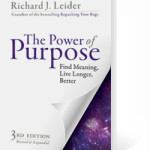“This is the true joy in life, the being used for a purpose recognized by yourself as a mighty one… the being a force of nature instead of a feverish, selfish little clod of ailments and grievances complaining that the world will not devote itself to making you happy.” – George Bernard Shaw
I’m often asked, “Why is it so hard to find my life’s purpose?” Over the decades, I’ve heard many people say that they don’t know what they’re really here for, on this earth. They feel a hunger for the “true joy in life” that Shaw promises.
And yet, I hear the stories of many others who have found and live in sync with their true joy in life. Here are some of my observations about why some don’t, and how they differ from those who do.
First, I observe that most of us, eventually, feel a pull toward some defining purpose to our life. It’s experienced as an inner urge to make things better. In fact, there’s an “evolutional impulse” in all forms of life to make things better – whether it’s a bird building a nest or a tree that produces seeds. But we humans become distracted by “hurry sickness” – busyness. Busyness is an addictive distraction that blurs the clarity of our inner urge.
I’ve often coached people who’ve become “successful” in their work – their “outer lives” – and, yet they feel empty, unfulfilled in their “inner lives.” They evidence what I call “Inner Kill” – the art of dying without knowing it. They describe feeling “unsettled,” or incomplete, despite a conventionally successful life. They have an impulse to burst their “personal bubble” – the small world they have lived in, where they were the center of the world, and where they were focused on their personal happiness. This is a bubble we all live in some of the time.
They now want to go deeper, to experience the true joy that comes from living and working on purpose. Their goal is to “feel” purposeful. From this inner-experience, they can begin to put together words, images, metaphors, or symbols of some kind that capture that feeling. The result is a purpose statement that has deep resonance and captures their true aim in life.
Second, one thing is perfectly clear. Happiness was present, but fulfillment was absent. It’s important not to mix up seeking happiness with finding purpose. Happiness is what we experience in the daily flow of life – the outer world. But purpose is deeper. It’s more of “the true joy in life” – fulfillment – a sense of “growing and giving.” It transcends every day disappointments and successes. We see the pushes of pain and pulls of possibility as part of what we encounter on the road. They don’t distract us from our larger “aim”, our purpose, which is like a magnet pulling us towards it.
Third, there is a core commonality among those who seem to find their true joy in life. They use their gifts, passions, and values to serve “something” larger than themselves. That might be hard to imagine. But, giving our time, talents, or treasure from the heart comes naturally when we choose to serve something larger than our self-interest. The inner urge, our impulse to make things better, pulls us out of bed in the morning; it calls forth our spirit. This theme of service to some aim larger than our egos, larger than the “success” we were aiming for, takes many forms. Service towards something beyond ego is universally visible in those who’ve uncovered their purpose, at any age.
What is “Success?”
If you want to work towards the true joy in life, answering these three questions can give you important insights about the path you’ve been on, in relation to your larger life success.
Reflect on each question for five minutes. Jot your answers in a journal. If you have a “purpose partner” to work with, you can take turns where one person repeatedly asks the same question and the other person answers:
- Who am I in terms of what I have?
- Who am I in terms of what I do?
- Who am I in terms of my being?
This exercise give you a chance to push the pause button and to look separately at what you “have”, what you “do”, and who you are. It can give you a midlife correction or confirm that you’re moving in the desired direction.
We often confuse “who” we are with our stuff, our achievements, or our work. The unbundling of the “Who am I?” question into three parts helps us gain clarity of purpose. It is important to know the difference, and not to confuse what we have or what we do with who we are. Knowing this increases our chances of finding “the true joy of life.”
One distinction between happiness and purpose is “Self-vs-Other” mindset. People leading happy lives derive joy from receiving benefits from others. People leading purpose lives experience joy from giving to others. Purpose transcends the self while happiness focuses on giving the self what it wants.
On the purpose path, it’s not “what” we do, it’s “who” we bring to what we do to make things better.
Of course, answering the three core questions is hard, and we might get pushback from others who have their own definitions of success. There’s always someone who will tell us that we’re wrong.
What matters is becoming larger than ourselves. Once we do, we learn that there is no truer joy in life than making the lives of others a little better.
* * * * * * *
For a deeper dive into the question posed by this article, read The Power of Purpose – 3rd Edition (Berrett-Koehler, 2015) and do “The 24-Hour Purpose Retreat” – chapter 9, pp. 85-96.



